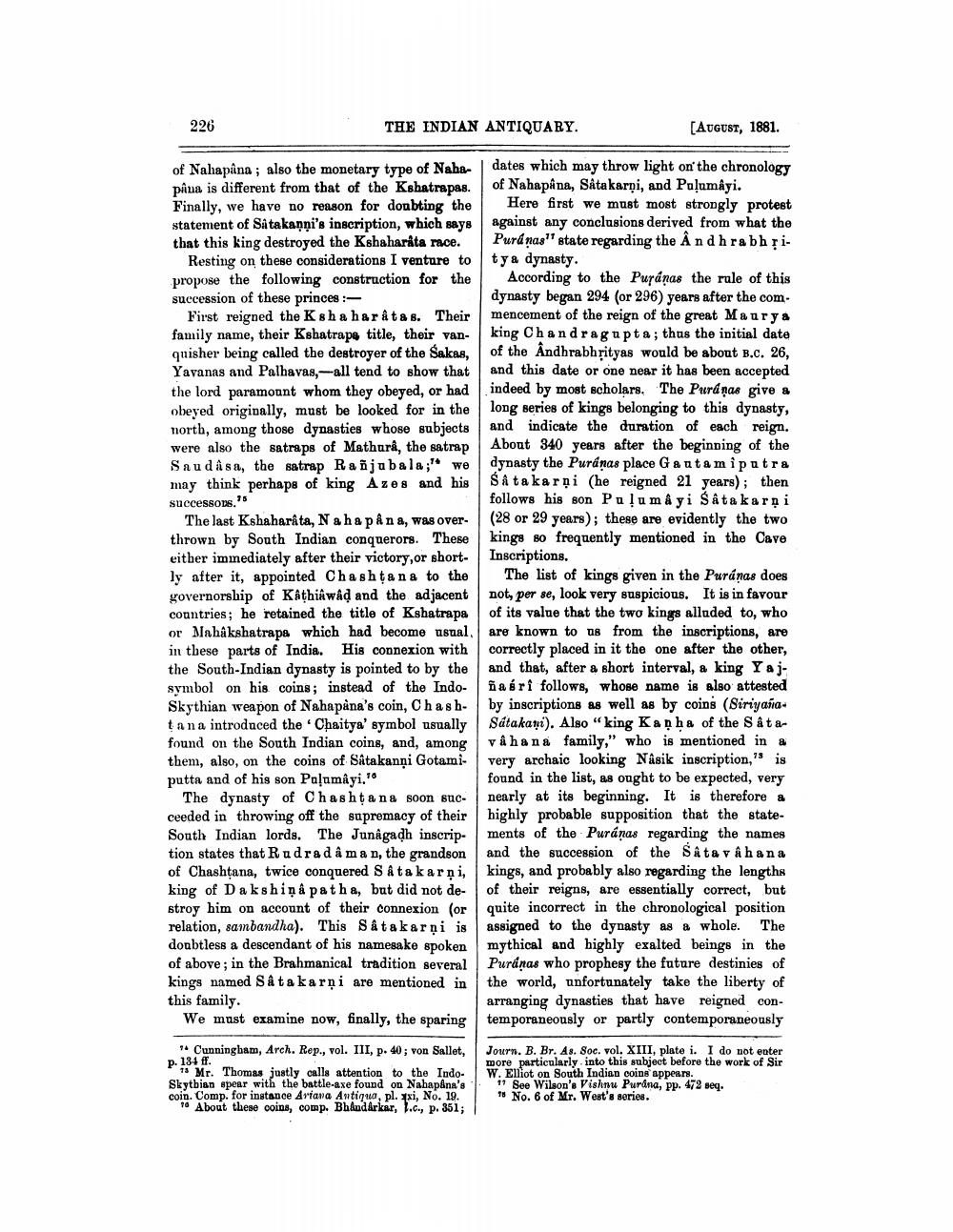________________
226
THE INDIAN ANTIQUARY.
of Nahapâna; also the monetary type of Nahapâna is different from that of the Kshatrapas. Finally, we have no reason for doubting the statement of Satakanni's inscription, which says that this king destroyed the Kshaharáta race.
Resting on these considerations I venture to propose the following construction for the succession of these princes:
First reigned the Kshaharâtas. Their family name, their Kshatrapa, title, their vanquisher being called the destroyer of the Sakas, Yavanas and Palhavas,-all tend to show that
the lord paramount whom they obeyed, or had obeyed originally, must be looked for in the north, among those dynasties whose subjects were also the satraps of Mathura, the satrap Saudása, the satrap Rañjubala; we may think perhaps of king Azes and his
successons.15
The last Kshaharâta, Na ha på na, was overthrown by South Indian conquerors. These either immediately after their victory, or shortly after it, appointed Chashtana to the governorship of Kathiawâd and the adjacent countries; he retained the title of Kshatrapa or Mahakshatrapa which had become usual, in these parts of India. His connexion with the South-Indian dynasty is pointed to by the symbol on his coins; instead of the IndoSkythian weapon of Nahapana's coin, Chashtana introduced the 'Chaitya' symbol usually found on the South Indian coins, and, among them, also, on the coins of Sâtakanni Gotamiputta and of his son Palumâyi.""
The dynasty of Chashtana soon succeeded in throwing off the supremacy of their South Indian lords. The Junagadh inscription states that Rudrad â man, the grandson of Chashtana, twice conquered S â takarni, king of Dakshinâ patha, but did not destroy him on account of their connexion (or relation, sambandha). This Satakarni is doubtless a descendant of his namesake spoken of above; in the Brahmanical tradition several kings named Satakarni are mentioned in this family.
We must examine now, finally, the sparing
Cunningham, Arch. Rep., vol. III, p. 40; von Sallet,
p. 134 ff.
13 Mr. Thomas justly calls attention to the IndoSkythian spear with the battle-axe found on Nahapâna's coin. Comp. for instance Ariana Antiqua, pl. xi, No. 19. 10 About these coins, comp. Bhandarkar, .c., p. 351;
[AUGUST, 1881.
dates which may throw light on the chronology of Nahapana, Satakarni, and Pulumâyi.
Here first we must most strongly protest against any conclusions derived from what the Puranas" state regarding the Andhra bhrity a dynasty.
According to the Puranas the rule of this dynasty began 294 (or 296) years after the commencement of the reign of the great Maurya king Chandragupta; thus the initial date of the Andhrabhṛityas would be about B.C. 26, and this date or one near it has been accepted indeed by most scholars. The Puranas give a long series of kings belonging to this dynasty, and indicate the duration of each reign. About 340 years after the beginning of the dynasty the Puranas place Gautamiputra Satakarni (he reigned 21 years); then follows his son Pulumâyi Satakarni (28 or 29 years); these are evidently the two kings so frequently mentioned in the Cave Inscriptions.
The list of kings given in the Puránas does not, per se, look very suspicious. It is in favour of its value that the two kings alluded to, who are known to us from the inscriptions, are correctly placed in it the one after the other, and that, after a short interval, a king Yajñaéri follows, whose name is also attested by inscriptions as well as by coins (Siriyaña. Sátakani). Also "king Kanha of the Sâtavâhana family," who is mentioned in a very archaic looking Nâsik inscription," is found in the list, as ought to be expected, very nearly at its beginning. It is therefore a highly probable supposition that the statements of the Puránas regarding the names and the succession of the Satavahana kings, and probably also regarding the lengths of their reigns, are essentially correct, but quite incorrect in the chronological position assigned to the dynasty as a whole. The mythical and highly exalted beings in the Puránas who prophesy the future destinies of the world, unfortunately take the liberty of arranging dynasties that have reigned contemporaneously or partly contemporaneously
Journ. B. Br. As. Soc. vol. XIII, plate i. I do not enter more particularly into this subject before the work of Sir W. Elliot on South Indian coins appears.
11 See Wilson's Vishnu Purána, pp. 472 seq. 15 No. 6 of Mr. West's series.




